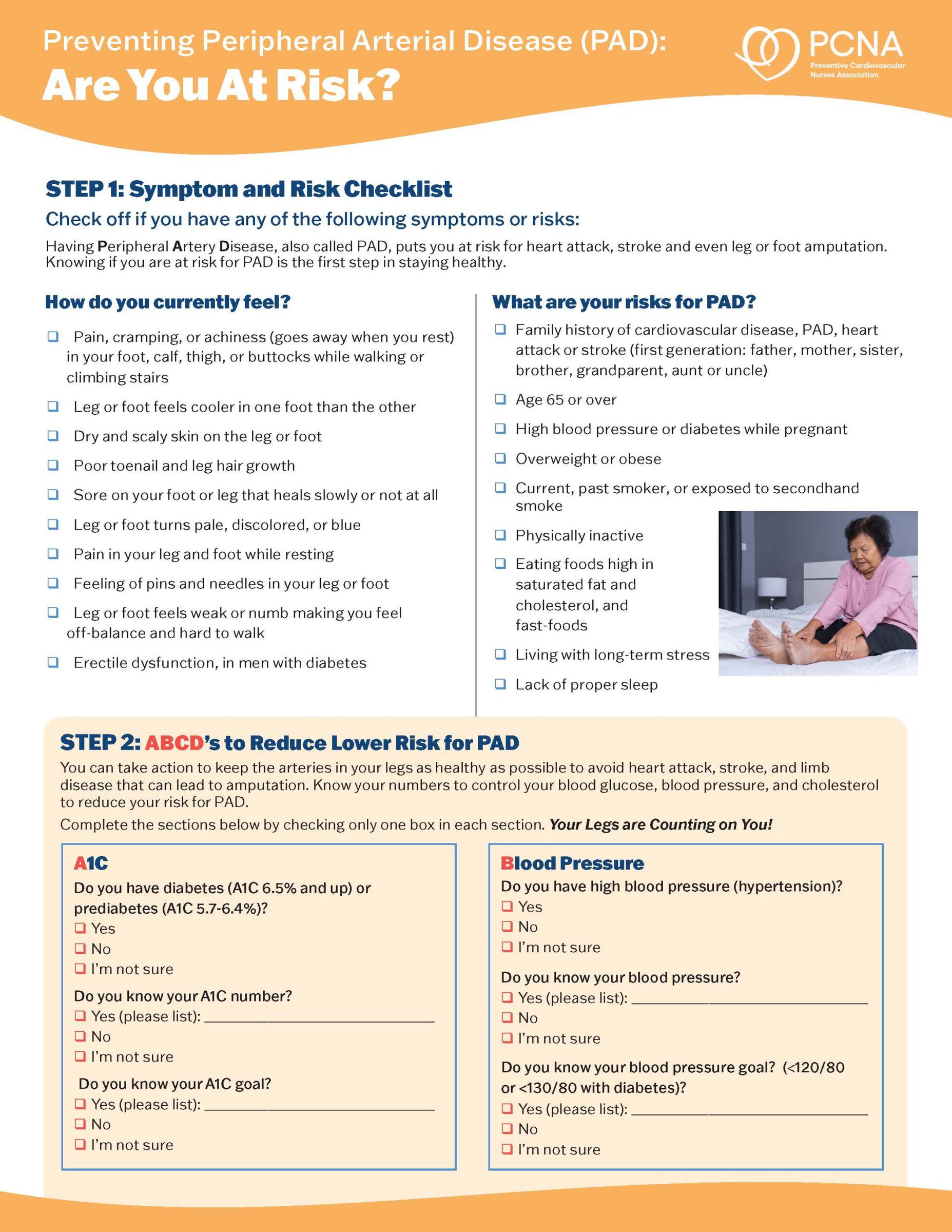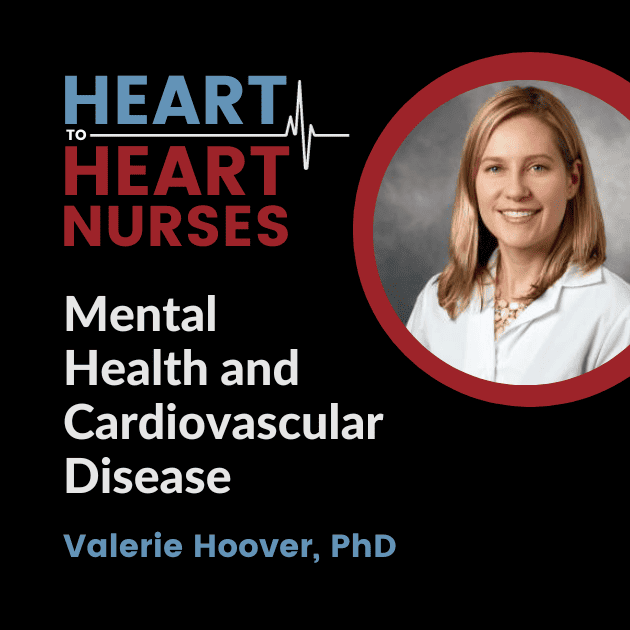The prevalence of mental health issues is greater in patients with cardiovascular disease than in the general population–but do you know what to look for? Guest Valerie Hoover, PhD, discusses the connection of both positive and negative psychological factors on cardiac outcomes, the importance of symptom recognition, and how regular screening for depression using a validated tool can make a significant difference for patients.
Episode Resources
- Assessment of Depression and Depressive Systems. Depression and Coronary Heart Disease (AHA 2008)
- Screening and Management of Depression in Patients with CVD (ACC 2019)
- Depression Screening and Treatment Guidelines in Cardiac Patients (2022)
- Comparison of PHQ-2 and PHQ-9 to Predict Death or Rehospitalization in Heart Failure (Circulation, 2015)
- PHQ-2 and PHQ-9 (Heart Foundation) – PDF
- Cardiac Distress Inventory (Australian Centre for Heart Health)
- Psychosocial Factors and CVD (JACC 2020)
Welcome to Heart to Heart Nurses, brought to you by the Preventive Cardiovascular Nurses Association. PCNA’s mission is to promote nurses as leaders in cardiovascular disease prevention and management.
Geralyn Warfield (host): We’d like to welcome our audience today to our conversation with Dr. Valerie Hoover. And could you please introduce yourself to our audience?
Valerie Hoover (guest): Yeah, happy to. So, it’s great to be here. I’m a cardiac psychologist and was a Clinical Assistant Professor at Stanford in the Cardiac Behavioral Medicine service from 2015 to 2022. I’m on the adjunct faculty now and do cardiac psych work in my private practice.
Geralyn Warfield (host): So, we spend a lot of time in the cardiovascular health sphere talking about disease states, talking specifically about treatments, talking about prevention. But we’re going to cover a pretty important topic [00:01:00] today, and that has to do with mental health issues and cardiovascular disease. If you could start out for us talking a little bit about the prevalence of mental health issues in cardiac populations, please.
Valerie Hoover (guest): Yeah, happy to speak to that. So, I guess one thing to know would be that, so there’s a number of psychiatric mental health disorders that are more prevalent in cardiac patients compared to the general population, including things like depression, various anxiety disorders, post-traumatic stress disorder, panic disorder. So, it’s really kind of across the board for the most part, this elevation that we see in the prevalence of mental health issues.
Geralyn Warfield (host): So, tell us a little bit [00:02:00] more about what that might look like, because I think we as clinicians are probably not quite as trained in recognizing the symptomology perhaps that we need to look for, and maybe what this next step should be for our patients.
Valerie Hoover (guest): So, I’ll speak a little bit about depression first. So, depression is approximately two to three times more prevalent among cardiac patients than in the general population. And it’s also been found to have an association with adverse cardiac outcomes. So, a really important one to screen for. Screening is also recommended by the American Heart Association, routine screening for depression.
So, depression, kind of the cardinal symptoms would be persistently low mood, and loss of interest in things that someone used to enjoy. So, a hard time kind of deriving pleasure or joy from [00:03:00] their daily activities.
And, you know, we kind of have normal fluctuations in mood. We all probably have some experience of that at some point. The difference with depression is that people are down, and they stay feeling down, for at least a couple of weeks–more likely it’s months, like six to nine months.
There’s some other symptoms that kind of go along with depression as well. We can think of some of these as more kind of mood related, or cognitive, and then others as kind of more physical or somatic.
So, some of the somatic symptoms would be things like changes in appetite in either direction. So, you know, having more or less of a desire to eat, possibly even weight changes.
Differences in sleep–either wanting to sleep a lot more or having trouble sleeping. Trouble concentrating. And then, folks will also often kind of have changes in how they feel about themselves, or [00:04:00] a sense of almost like kind of disconnection from other people, and a tendency to self-isolate.
And, of course, with depression, it’s not uncommon—especially kind of more moderate to severe depression—it’s not uncommon for folks to have thoughts of, you know, anything from, “You know, gee, it would be easier if I just didn’t wake up in the morning,” all the way up to, “I don’t want to live, and I have a plan, and I intend to follow through on that plan,”’ and a lot in between.
And so, just kind of, I think it’s helpful to kind of be aware of how common those types of thoughts are. It doesn’t mean that patients are going to make an attempt to end their life. It’s more kind of representative, I think, of how hopeless they can feel. And certainly, you know, if there is suicidal ideation, we want to address that. But also, it can just kind of be a reflection of some of that hopelessness.
Geralyn Warfield (host): So, when a patient gets a diagnosis of heart failure, for example, the word fail is right in the name of that disease. I [00:05:00] understand where that might be a pretty obvious patient that we might want to screen for, but from what I’m hearing, it sounds like it’s much more pervasive than just in our most severely impacted patients.
Valerie Hoover (guest): Yeah. Yeah. great point. So, absolutely, it’s a big issue among, you know, highly prevalent among folks with heart failure, but also prevalent in folks with other kinds of cardiovascular disorders as well. And so, we really need to kind of be thinking more broadly about screening folks with cardiovascular disease for co-occurring mental health issues.
Geralyn Warfield (host): And you also had mentioned about screening tools. Could you talk a little bit about if these are traditional screening tools that would be used in other situations or if there’s some cardiac-specific tools that we would use?
Valerie Hoover (guest): Yeah, happy to speak to that. So, traditionally, and actually there was a, I’m thinking of a paper that, it was a white paper that the AHA put out, I want to say in 2009, recommending initial screening with [00:06:00] what’s called the Patient Health Questionnaire-2, or the PHQ-2. And following that up with what’s called the PHQ-9, just a more in-depth screener for depression. And doing that with all cardiac patients.
And JACC published a review in 2019, kind of saying the same thing, right?
So those are, you know, if you’re thinking about doing some sort of depression screening in your setting, you know, starting with a PHQ-2. It asks about those two cardinal symptoms of depression that I mentioned earlier, in the past two weeks. A score of three or more would indicate a positive screen, and then you would want to follow that up with a more in-depth assessment like the PHQ-9.
And, again, if I can get the resource for that JACC article. There’s a detailed kind of explanation of how to kind of move through that screening process that’s probably beyond the scope of what we can cover here today.
Geralyn Warfield (host): We’ll be sure to put that link to that resource in the show notes for our [00:07:00] listeners.
Valerie Hoover (guest): And then, one other thing I’ll just mention when thinking about screening. I think the second part of your question was something about like, is there a cardiac-specific measure? And in the past, the answer would’ve been, “There’s a bunch, and they’re all piecemeal, and they all kind of look at one piece of it.”
But recently, actually, so, my colleagues at the Australian Center for Heart Health in Melbourne, Australia developed—and we were one of the sites, at Stanford, that tested it along with some other sites—a comprehensive measure of distress, cardiac distress, in this population.
It assesses eight different areas of psychosocial functioning. And it’s really available. So, you can just go to the Australian Center for Heart Health, their website, click on resources, and you’ll see it’s called again, Cardiac Distress Inventory or CDI; [00:08:00] free to download and, and use. And I believe you can access the article, reporting kind of the study results of and, and how it was tested.
I’ll mention, so this is kind of a lengthy measure—it’s 55 items. So, there’s now also (it’ll be released shortly) a 12-item measure that’s going to be a lot more feasible for a lot of professionals in, in various settings than a 55-item measure, I think. We’re waiting on the results to be published. But once they’re published, that’ll also be up there on that website and freely available.
Geralyn Warfield (host): So, in terms of what this looks like in clinical practice, I suspect that a clinician might have a patient where there are indications that there might need to be this next step. Do those resources get utilized in that same clinical visit so that you can have immediate results?
Valerie Hoover (guest): Mm, great question. So, if I’m just understanding correctly, let’s say a provider’s, you know, working with a [00:09:00] patient, or a nurse is working with a patient, and they have a sense, you know, this patient, “I’m sensing some depression here, let’s screen for this.”
Geralyn Warfield (host): Yes.
Valerie Hoover (guest): Absolutely. Yeah. And it’s, you know, if there’s already a screening process in place, maybe they filled out that screener ahead of time and you can just kind of initiate that conversation with them about, you know, mood and depression and possible treatment, from that screener.
If it’s not already, you know, part of the screening procedure in the setting where you’re in, you know, absolutely you could, you could get out the screener and kind of go through it with them.
I find it’s helpful to kind of normalize it. I think, unfortunately, it’s getting better, but I think there still is this stigma around mental health. So just kind of saying something like, you know, “We often,” (or “always,” if it’s with every patient) but, “We, you know, we often like to screen our patients for depression. We know it’s two or three times more common if you have a cardiac condition. And it actually, you know, folks tend to not do as well medically if it doesn’t get treated. [00:10:00] So would it be all right if, we take a couple minutes to do a quick screener?”
Geralyn Warfield (host): And also, for the clinicians to be thinking about next steps about what those results look like.
So, in your clinical setting, obviously, you may be receiving referrals from clinicians. Is that how that works?
Valerie Hoover (guest): Exactly, yeah. Yeah. So, in kind of how I function as a cardiac psychologist, so, I’ll get a referral from a member of the treatment team.
Cardiac psychology is a bit of a newer field, so, there’s not many people doing what I do. But, if you don’t have a cardiac psychologist, some other options would be if there’s, you know, someone on the medical team.
So, let’s say that the patient screens positive. You know, it’s clear they have depression. The current recommendation would be to initiate a medication like an SSRi. And, so if there’s, you know, a member of the medical team who can [00:11:00] prescribe that and is comfortable doing that, that would be one option.
You could also loop in the primary care provider if the patient is hospitalized.
You can get a psychiatry consult or refer out as well.
For patients who would prefer not to do medication, or who have tried medication and failed an initial trial, a referral for therapy is also a great option.
Geralyn Warfield (host): We’ve been talking about the connection of mental health and cardiovascular disease, and we will be right back.
Geralyn Warfield (host): And we’re back, talking about cardiovascular disease and the links to mental health.
I’m hoping, Valerie, you could talk a little bit about how cardiovascular outcomes are impacted by mental health.
Valerie Hoover (guest): Absolutely. So, what immediately comes to mind, so there was a white paper put out by the AHA. It was a couple years ago, I think in 2021, looking at and reviewing the current state of the literature on positive and negative psychological factors [00:12:00] and various cardiac outcomes.
And what they found is that a number of psychological factors, in addition to depression, are associated with, you know, things like, greater incidence of, incident CHD, MI, mortality.
And yeah, just to give you a flavor of some of those other factors that show an increased risk are things like PTSD, social isolation, loneliness, stress (both specifically work stress and any cause stress), anxiety.
Anxiety, if I’m remembering correctly, that one of the findings that really kind of struck me is a 420% increased risk for coronary artery spasm for folks with high levels [00:13:00] of anxiety. So, really kind of striking effect.
They also found an association of pessimism—so kind of this overall tendency to predict negative outcomes or ascribe a negative interpretation to kind of more ambiguous events—that was also associated with greater odds of CHD mortality.
On the flip side of that, and this is a relatively newer area of research, but I mentioned they also looked at positive psychological factors and cardiac outcomes.
And positive psychological factors—so, this is more than just the absence of things like depression or PTSD or anxiety. It’s the presence of things like optimism, like having a sense of purpose, a greater sense of [00:14:00] mindfulness, having a more kind of positive affect, or reporting higher levels of happiness.
All of this has been associated with actually reduced risk for some of those same outcomes.
And the good news there, one of the things that I find really heartening, so to speak, is that a lot of those are qualities and kind of states of mind, and stances, that can be cultivated and developed. And yeah, so I find a lot of hopefulness in that and I’m hoping there’s a lot more to come on that topic in the next number of years.
Geralyn Warfield (host): It’s incredibly insightful that we can have a positive impact with some of these outcomes for our patients as well. And as you were speaking about those connections between mental health and cardiovascular disease, in both directions, they impact one another, it came to mind that those individuals who are not just patients, but families, caregivers, those types of individuals are [00:15:00] also at greater risk, then, for cardiovascular disease if they perhaps have somebody who’s been recently diagnosed or is going through a chronic condition.
So, in some ways this is a family affair in terms of making sure that patients and their close friends, their families, have access to resources and information. Is that accurate?
Valerie Hoover (guest): Yeah. That is such a great point. Yeah. So, you know, like you said, right, in addition to the patient, there’s kind of these outward ripple effects. So, both kind of directly, you know, they’re, especially depending on the condition, there may be like an increased risk for that same issue in family members, you know.
And in addition to that, kind of the stress and the difficulty that having, you know, a family member who’s maybe gone through some kind of…gotten a new diagnosis or had some [00:16:00] kind of cardiac event, just kind of the fear and kind of how that disrupts kind of that social, that family unit or that social unit.
Yeah. And then, you know, there can be this thing, you know, it really depends on, you know, it’s obviously a little bit different with everyone, but something I’ve seen a lot in my work is kind of this dynamic that can unfold where, you know, the patient just had this thing happen, or gotten this diagnosis, and they’re concerned about either being a burden or becoming a burden.
And that might make them a lot more reluctant to ask for, you know, emotional support or kind of instrumental help with something.
And, you know, in turn, family members, like they, you know, they generally, they want to help, right? And so, it can just set up a difficult dynamic when the patient, you know, [00:17:00] has this sense of, or fear of, becoming a burden, so maybe isn’t kind of as open to accepting help; the family member wants to help, maybe it doesn’t know how to. It can just be difficult.
So, I think, something I try and, you know, remind my patients of is, you know, when we allow others to step in and help us, not only does that benefit us, but it benefits the other person.
And, you know, all we have to do is kind of think about a time where, kind of we’ve been in that position, right? So, maybe a friend or a family member asked us for help, or confided in us, or opened up to us, and kind of, really reflecting on kind of how that made you feel, and how that benefited the relationship perhaps.
And so, you know, what’s good for the goose is good for the gander. So, maybe being more open to accepting that help as well, if you’re in the patient role.
Geralyn Warfield (host): So, we’ve been having a fascinating conversation about the [00:18:00] links between mental health and cardiovascular disease. Is there anything else that you would like to add that we’ve neglected to talk about already?
Valerie Hoover (guest): I think those are the big things. I will just say, just I guess to kind of attempt to sum it up, you know, we know that a number of different, many different psychiatric disorders are more common among cardiac patients, including depression, anxiety, PTSD.
And so just, you know, to kind of be aware of that in working with patients.
And, you know, perhaps having screening procedures in place to help identify them. Or if they’re not in place, like I think I may have mentioned earlier, you know, if you’re picking up on it during an interaction, taking that moment to kind of dig a little deeper and then, kind of, doing what you can.
Ultimately, it’s the patient who will decide if they’re going to accept and pursue help and treatment.
But kind of [00:19:00] having that conversation and you know, doing what you can to kind of help get them connected.
Geralyn Warfield (host): I really appreciate your insights into this added dimension of healthcare for our patients who often have very complex health issues already, to be aware of their mental health and how we can help them in all those spheres and have the resources there.
Thank you so very much for being with us today. I’m your host, Geralyn Warfield, and we will see you next time.
Thank you for listening to Heart to Heart Nurses. We invite you to visit pcna.net for clinical resources, continuing education, and much more.
Topics
- Atherosclerotic Cardiovascular Disease (ASCVD)
- Heart Failure
Published on
December 5, 2023
Listen on:
PhD
Related Resources




Online Interactive Guides
Cholesterol: Journey to a Healthier Lifestyle Online Interactive Patient Guide
February 12, 2025






